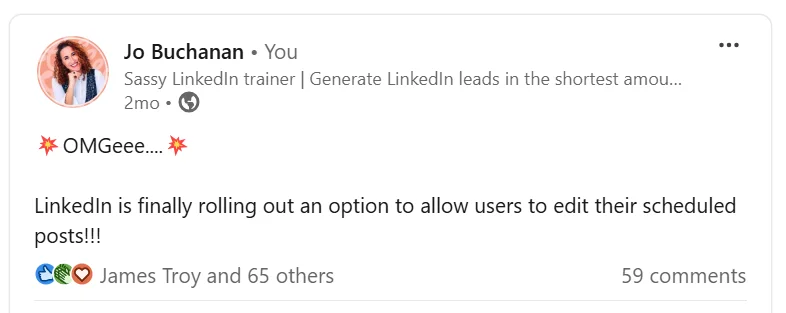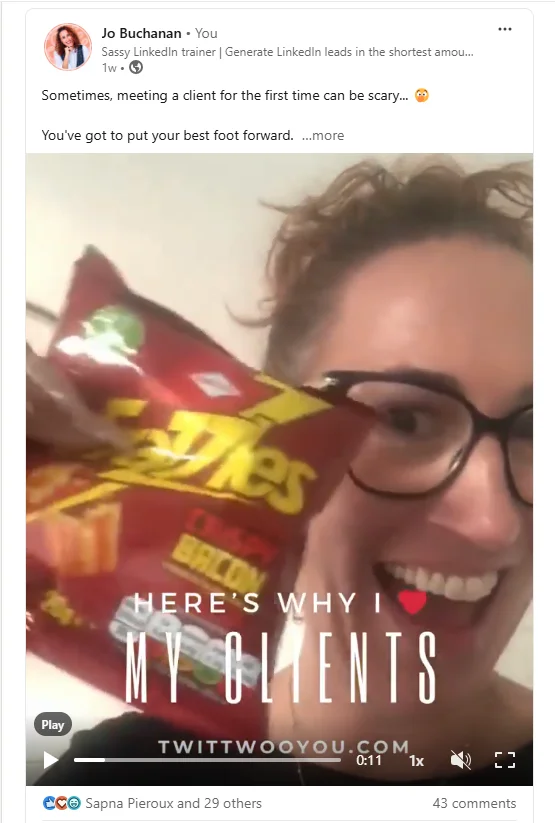LinkedIn is big, like BIG! The latest stats from social pilot.co claim that over 1 billion members from 200 countries use LinkedIn.
LinkedIn is a goldmine for marketers and business owners alike. And while that might be all well and good, I know what you’re thinking…
How can I make the most of this platform?
This article should help you learn how to post effectively on LinkedIn.
Why LinkedIn matters
LinkedIn isn’t just another social media platform; it’s a unique space where professionals connect, share insights, and create opportunities.

LinkedIn’s reach potential is also significant, especially considering that only about 1% of users actively post content. This means you’re already ahead of the game by simply showing up and sharing what you know if you join this elite club.
Integrating LinkedIn into your marketing strategy
Before we delve into the ‘how’ of posting on LinkedIn, it’s crucial to understand the ‘why’.
LinkedIn offers a broad spectrum of benefits beyond just sales. It’s a platform for building awareness, fostering relationships, and establishing thought leadership.
When considering LinkedIn as part of your marketing tactics, consider how it fits into your overall strategy. It’s particularly effective for:
- Awareness: Sharing thought leadership content to reach a wider audience.
- Retention: Keeping your network updated on your progress and offerings.
- Advocacy: Encouraging satisfied clients to share their experiences.
Remember, LinkedIn isn’t primarily an acquisition channel. While it can drive sales, being too aggressive with sales pitches can backfire. The key is to provide value and build relationships first.
Personal Profile vs. Company Page
When preparing LinkedIn posts, my clients often ask me where they should post them. For example, is it better for them to post on their company page or on their personal profile?
Personal profiles generally outperform company pages. The algorithm favours individual users, and people tend to connect more with individuals rather than brands.
However, this doesn’t mean company pages are useless. For maximum engagement, focus on building your personal brand on the platform first, and then you can follow up on posts that have achieved good engagement on your company page.
What to write about
One of the most common questions I get from clients is: ‘What should I post?’ The answer lies in understanding your audience and your goals.
Here’s a simple approach:
- Identify your areas of expertise: What do you want to be known for?
- List topics related to these areas.
- Develop your unique perspective on each topic.
This approach helps you create a content matrix, giving you a wealth of ideas to draw from while maintaining consistency in your messaging.
Types of content that work well on LinkedIn
- Posts with images: These tend to perform well, taking up more screen space and catching the eye. And better still, if you can include a selfie, your post will perform even better. According to authoredup.com, a selfie can improve the reach of your post by 15-20%.
- Plain text: Easy to create and consume, plain text can be highly effective if well-crafted. However, if you are just going to post a text post, you should keep it short, like I’ve done here:

- Slide decks, aka the carousel: While LinkedIn told us they were getting rid of the carousel, I still see plenty of them on my feed. They are great for telling a more in-depth story while remaining visually engaging. You can use a free tool like Canva, which offers many free carousel templates. Simply switch out the images, text, fonts, and colours, and voila, you’ve got your own branded carousel!
- Videos: While they may get less reach, they can create deeper connections with your audience. And you don’t need to hire some expensive video producer; simply get in front of your smartphone and start chatting.

Crafting effective LinkedIn posts
Now, onto the good stuff. Here are some tips for creating posts that resonate:
- Start with a strong hook: Your opening line is crucial. It should grab attention and compel readers to click ‘See more’. It could be controversial, funny, curious, or bold. But you need something to grab the reader’s attention to stop the scroll.

- Tell a story: People connect with stories. Share experiences, lessons learned, or interesting anecdotes.
- Keep it simple: Page formatting is super important. There’s nothing worse than being faced with a great big block of text. Instead, break your post into short, digestible paragraphs. LinkedIn allows 1,300 characters, but you can use only some of them.
- Use personal pronouns: Write as you would speak to make your posts more relatable. Your authenticity will shine through. And what comes with authenticity? Trust. When people trust you, they are more likely to buy from you.
- Focus on one key message: Don’t try to cover too much in a single post. And if you really have to, convert it into a carousel to make it easier for your reader to digest.
- End with a call to action: This tip is so important. You wouldn’t believe the number of LinkedIn posts I see without one. You’ve gone to all that effort to create a great post, and then what? What do you want your reader to do? Scroll by? I think not.
- Encourage engagement: Again, too few people do this. If you ask an easy-to-answer question, you’ll invite more comments.
The power of consistency
Posting regularly is key to building momentum on LinkedIn. While daily posting works well for some, it’s important to find a rhythm that’s sustainable for you.
Remember, building an audience takes time, so don’t get discouraged if you don’t see immediate results.
Engaging with your network
Posting is only half the equation.
Engaging with others’ content and responding to comments on your posts is equally important. It also means you show up more often on the platform. By engaging with other people’s content, you will build relationships and signal to the LinkedIn algorithm that your content is valuable.

Avoiding common pitfalls
I know you hear it repeatedly, but don’t focus solely on likes and comments.
While engagement is important, it’s not the only measure of success.
Avoid ‘engagement bait’ posts that provide no real value.
Don’t include links in your main post text, which can limit reach. Instead, put links in the comments. LinkedIn doesn’t like it when you encourage users off the platform, so if they see a post with a link that takes the reader outside of LinkedIn, they won’t share it with as many of your network.
And another thing… Be cautious with tagging.
Only tag people when it’s genuinely relevant to them. If the people you tagged do nothing with your post, i.e., like, comment on it, or share it, LinkedIn will punish you and reduce the reach of your post.
So I hope, if you’ve read this far, you’ll realise that posting well on LinkedIn is about more than just following a set of rules. It’s about understanding your audience, providing value, and being authentically you.
As you develop your LinkedIn strategy, remember that building a strong presence takes time and consistency. Keep refining your approach, stay true to your voice, and focus on creating content that genuinely helps your network with a smattering of what makes you uniquely you.















